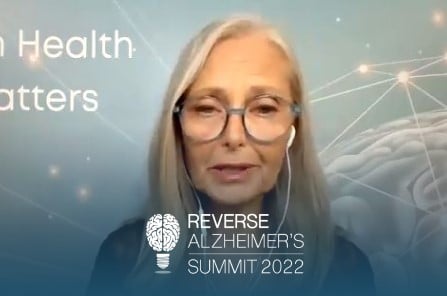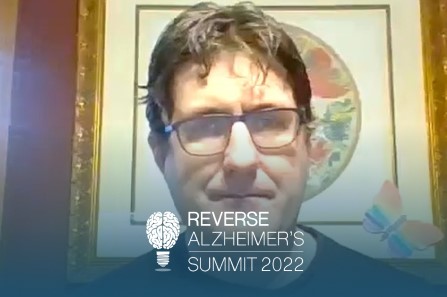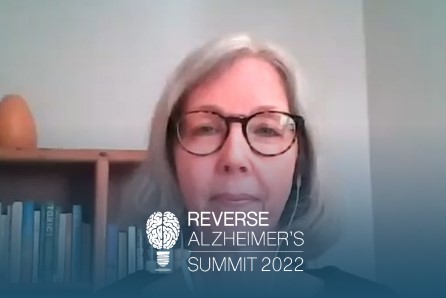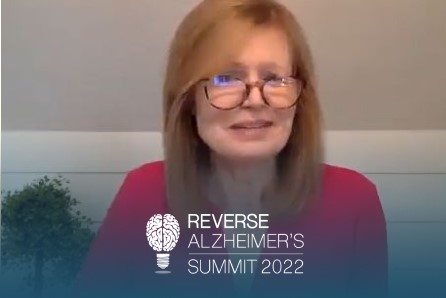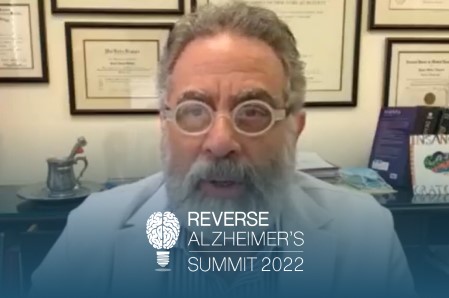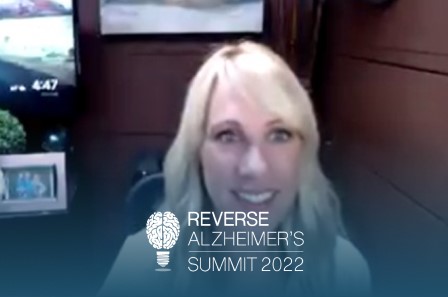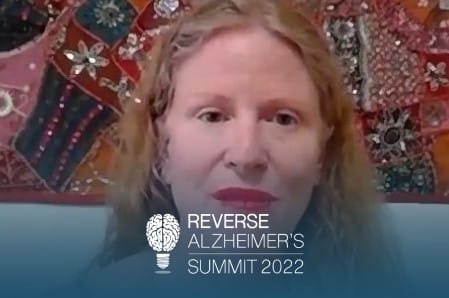Join the discussion below

Dr. Heather Sandison is the founder of Solcere Health Clinic and Marama, the first residential care facility for the elderly of its kind. At Solcere, Dr. Sandison and her team of doctors and health coaches focus primarily on supporting patients looking to optimize cognitive function, prevent mental decline, and reverse... Read More
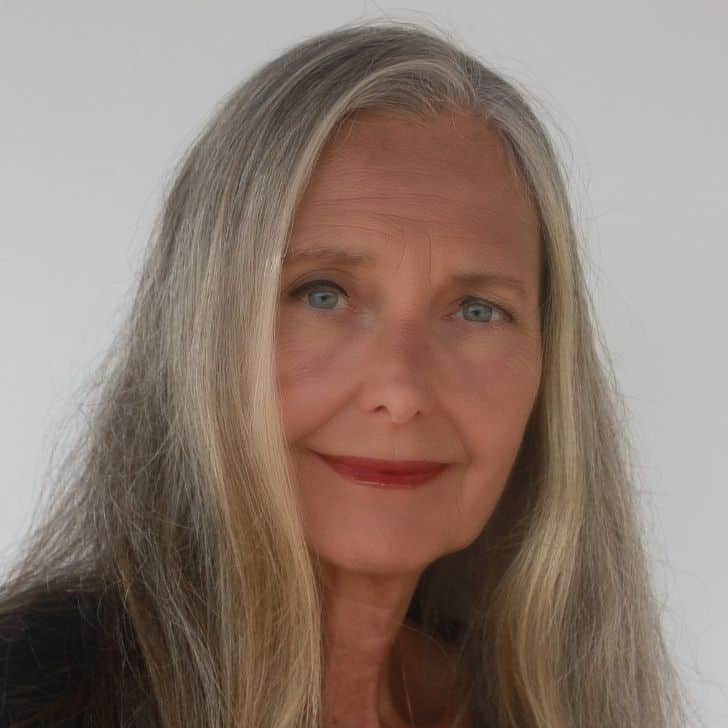
Kate Kunkel turned her mother’s tragic illness and death from dementia into her mission in life. When she learned that this and most dementias were preventable, Kate expanded her healing work as a sound therapist and vegan nutritionist and became an Amen Certified Brain Health Professional. Now, through coaching, retreats,... Read More
- Music, sound, and vibration therapy for memory;
- Vegan-Keto diets for brain health;
- The healing power of silence
Heather Sandison, N.D.
Welcome to this episode of the Reverse Alzheimer’s Summit. I’m your host, Dr. Heather Sandison. I’m so excited to introduce you to Kate Kunkel. She and I were connected by email recently, and I was just telling her that when I saw her email signature about her brain health matters podcast and all of the things that she has going on in the brain space, plus learning about her personal story, where she was suffering along with her mother who’s a tragic illness and death from dementia, she turned this tragedy into her mission in life. Really what we hope everyone will do is transform this sort of tragedy into purpose and meaning and helping others. And so when she learned that this and most dementias were preventable, Kate expanded her healing work as a sound therapist, a nutritionist, and became Amen certified brain health professional, which I can’t wait for her to share more about all of these things with us. Kate welcome.
Kate Kunkle
Oh, thank you. I’m so happy to be here with you. I was just mentioning that I feel like I know you, I watched so many of your episodes last year and I bought the package because I wanna be able to speak as intelligently as I can to my clients and the people that I have on my show to just, you know, make the information, get out there. I feel it’s so important to have the information available to people every way we can.
Heather Sandison, N.D.
So important. And thank you for this year, becoming one of these experts who can share their wisdom and you really bring this very unique perspective. And so you’re also the international bestselling author of Don’t Let the Memories Fade: A Holistic Guide to Preventing Dementia and the Healthy Brain series of short reads, including The Vegan Brain, The Plant Lover’s Fast Start Guide and The Musical Brain. So you have all of these ways that you are sharing this information through your podcast, through your books and your passion and empathy is clear from just even a few moments of knowing you. So let’s get into it here. I’m curious about no one else on the summit is talking about music and the brain. So this is just this really unique perspective. How did you come to do this work?
Kate Kunkle
Music has been my life. I started piano when I was four years old. Thanks to my poor mother who’s no longer with us, but music has been such a huge part of my life. And when I began to work with people as a harpist, I became a harpist at the age of 32. It took me a little while with the harp, but harp is very much used as a healing instrument, right? So I got so involved. I worked with people with MS because I heard about this gentleman, Dr. Ron Price, he was a music instructor in Chicago, and he developed Parkinson’s, a form of Parkinson’s. And when I learned that he was able to reverse his symptoms and improve his life. I mean, he went even back to being able to play the trumpet, which is quite a big deal, you know, when you have Parkinson’s using the harp. So that got me on this path. I had to learn more about this. And I happened to be working at a hotel in Las Vegas, the Excalibur. And I had a coworker whose wife had MS. She was young, maybe 42. And she was in a wheelchair and it had progressed so much that she was not able to actually use her hands to type or anything like that anymore. And it was devastating for her, you know, besides the wheelchair, she had these other problems. So I said, “Look, let’s give it a try. We’ll see what we can do to try and reverse this,” because I told them about Dr. Price. And it took us about six months. We got her a little lap harp, and we started working just to get her hands to move again. That was the goal to be able to get her, to use her fingers. So we worked first, I was just taking her hand and literally running it along the strings to get the vibration going. And that’s the trick to get the vibration, the frequency going through the body. Now that I know more about it, I realize why that worked, but that was the start of my journey into this wonderful world, wonderful world of music healing. And of course, when my mom was diagnosed with dementia, I was devastated. Here I am, I’m supposed to be helping people and mom’s got dementia. Of course I was, you know, 3000 miles away. So it made it a little bit hard, but I still felt so guilty. And I had to start doing research and see what we could do in addition to the music to help her.
Heather Sandison, N.D.
Wow. So you mentioned that the vibration has a lot to do with this. So tell us what you’ve learned over the years. How does music therapy work?
Kate Kunkle
Well, music therapy is very different from sound therapy. So music therapy is very much a connection between a music therapist and a client. And it is like almost like a psychologist, right? A music therapist. Sound therapy on the other hand, uses frequencies to counteract sometimes to improve, whatever the ultimate goal is. For example, I do something called Vibroacoustic therapy. In that case, we put a client on a specially designed bed, so to speak, a lounge. In that lounge are transducers. The transducers conduct sound as frequency, as vibration directly into the body. By doing that, we bypass the emotional and psychological impacts of music. We’re still using kind of music, but mostly it’s just frequencies. We’re getting by all that and we’re actually changing the way the body is vibrating. We know, for example, that 40 Hertz is the base frequency for our brain, for if we’re in the gamma state, which is the most active, right? So if we’ve got 40 Hertz working on the Vibroacoustic, I’m pointing over here because my bed is over here. If we’ve got that working, then we can actually inspire the brain and the body to resonate at a frequency that is healthy and more healing.
Heather Sandison, N.D.
And so what does this mean at a cellular level.
Kate Kunkle
At a cellular level we’re actually working on the cells, does a couple, whole bunch of things. It inspires neurite growth where actually have research that’s come from I think they were Italian, don’t quote me on that. Some researchers, no, Japan, Japan, they actually inspire neurite growth by exposing the brain cells to the 40 Hertz, only the 40 Hertz for some reason. We don’t know why, it’s one of those things you just have to, you know, okay, well, that’s the one. We are also able at that, so we’ve got growth. So we’ve got neurogenesis going on, which is amazing. And then we can also help the cells oxygenate more. ‘Cause what is one of the problems with dementia and Alzheimer’s, we don’t have enough oxygen. So people who have like COPD and other issues like that are more likely to develop dementia because they’re not getting enough oxygen to the brain. So what that we can do with frequencies, and it can be not just the 40 Hertz, but with other frequencies, we help the blood circulate better and we are actually oxygenating the cells. So there’s all kinds of things going on. The most important thing to remember is that we are able to alter through frequency itself, not through psychological intervention or having people play an instrument or sing. We can actually do this. And so that even if people are not particularly cognitive, we can still inspire changes.
Heather Sandison, N.D.
Wow. How amazing and oh, a sound, I certainly have experienced this, right? Like I can play some music from my youth all the way into school and get this nostalgic feeling excuse me, I said to school, even because back when I was going to school like the music of my youth on the way into work will like set the tone for my day. And I’m feeling really hopeful and energetic. And then I can also put on the music of like right now, like club music and I’m like, all right, when are we going to Vegas? Right? Or the music to kill yourself too. Like the stuff that can be really depressing. So I have personally experienced this. I think we can all relate to that at some level that music and noise sound, maybe not even noise, but like there’s this spectrum of what it elicits in us. And so there’s the good and the bad. And can you kind of talk about what that spectrum looks like and how we can use this to our benefit?
Kate Kunkle
Sure. So one of the things I talk a lot about, especially to my younger clients is noise. It’s too much sound because as you know, we risk hearing loss if we have too much noise, but also the frequencies of certain noises are very disruptive to our bodies. Good example here, if you go to a restaurant where in that restaurant, road houses are famous for this, you have music going usually really loudly and very kind of rocky. You also have probably some kind of a game on a big screen television, right? Football or baseball or something. You have very loud dining because they’re trying to get over all the noise to talk to each other. This is absolutely not good for your digestion, number one, it disrupts the microbiome, number two, and you eat too fast. So you eat too much, too quickly and they depend on that, right? They want you, it’s not by mistake. That’s very much on purpose that that is then you will eat more, you’ll drink more and all of those things. So that’s one example of the not so good.
Heather Sandison, N.D.
Wait, I’ll Just share. When I first stepped into what is now Marama, when we were looking at purchasing that property, the room I walked into had three TVs with different things on it. One was like a sports game with the sound of the whistle. Another was news. And then another was like an infomercial or something ridiculous. And I couldn’t think straight, right? And this was a big deal in my life. I was like, all right, are we gonna do this or not? And I couldn’t believe that there were people sitting in wheelchairs just being inundated by this sound that was so anxiety provoking and uncomfortable for me. And that they were sitting in there saturated in that all day long.
Kate Kunkle
Oh, you know, that is one of the things when I first went to see my mother in the nursing home, when she first went there, I lost it. I absolutely lost it on the administrator. I said, “How can you do that to these people?” It was the same kind of situation, it was loud. It was inane, nonsense that nobody should have to listen to. And these poor people don’t even, everybody in that facility had cognitive issues. These poor people couldn’t even speak up against it, you know, to try to stop it. It made me crazy. I was very upset.
Heather Sandison, N.D.
And I think people go into it well intentioned, right? Like, “Oh, here, we’ll put this on for entertainment. And this will make them feel less lonely,” and not realizing what a potentially harmful impact it’s having.
Kate Kunkle
Yeah because besides it causing stress, we also, as we age, we do have a certain degree of hearing loss, most people, not my mom, she could still hear a mosquito squeeze. You know what I mean? From very far away, she could still. But we do have hearing loss. And when we have hearing loss, as you I’m sure know, we have to work harder to get information and to remember, and to be able to filter that. If you’ve got all that noise, it makes it even harder for that to happen. So if somebody’s talking to you, how are you going to answer them? How are you going to filter out the noise and actually get what you need out of it so that you can respond or remember? So I think that’s a very important thing for people to remember for themselves. Because if you are beginning to suffer hearing loss, get something done for it. Like really seriously. You have to look after your hearing because that has such an impact. You have such a much larger chance of developing dementia if you have a hearing loss. Not so much because they’re intimately connected, but because if you can’t make sense of things, firstly, you’re gonna start withdrawing from people because you don’t wanna be embarrassed. So that makes it even more likely that you will develop dementia and it’s gonna make it harder for you to converse, learn or remember.
Heather Sandison, N.D.
And then also visual, we see this with vision loss, as well as people often will have macular degeneration. Also, you know, these are the end arteries and there’s some overlap between vision loss and dementia because blood flow to the head and face and the brain is very similar. Also the smaller arteries and they’re having inflammation. And then there’s some pathophysiological parallels there. And so when we start to lose our vision, lose our hearing, lose our senses, sense of smell is also an early sign of cognitive loss. When we lose these senses, there’s less inputs going into the brain and it’s kind of like a muscle you’re not building anymore. And when you lose it, when you don’t use it, you lose it. Right? And this comes up here. So if we’re not getting, we’re sort of the sum total of everything we allow in, the food, but also these sensory stimuli. And so of course hearing is so important. So, so, so important. Sometimes I see maybe your mom was like this our senses of smell disappear. The hearing is a little bit more attuned. And so people will say hearing improves sometimes with age. Have you seen that?
Kate Kunkle
I haven’t seen that too much. Except of course, my mom has always had good hearing and I got it from her. I can hear a bee sneeze, you know, but some of us are I guess, blessed mostly with that, but I haven’t seen that so much, but I have certainly seen how people withdraw when they don’t hear well. Like my dad had three strokes and the last stroke affected his hearing. So he’s a very personable guy. He’s not an easy guy, but he’s a personable guy. And I found him like avoiding people and I’m like, “Daddy, what’s wrong?” It’s because he couldn’t hear, he couldn’t make sense. And of course being so proud, he doesn’t wanna have hearing aids, but me and my sister made him get hearing aids because he was losing his connection to people.
Heather Sandison, N.D.
Yeah. And we see that when you have that isolation, people go down health so quickly, it’s heartbreaking. So you’ve talked a lot about the benefits of hearing, of optimizing sound for health and brain health in particular. And then what about musical education? So you’ve been at a piano since you were four. When do we need to start? Can we start at any age?
Kate Kunkle
Yeah. That’s the great news because everybody that, when I first started getting into this, people would say, “Oh, you have to do this from a child,” but no, it’s not true. Now we can develop a stronger corpus callosum if we start earlier, you know, with that band of fibers between the right and the left hemisphere is stronger if we start earlier, but we can still get the benefits of a musical education but partly because we develop more strength between the hemispheres. And also because then we are involved, we are learning, we are doing those new things that are so important for brain health, right? So it’s not just the music itself, it’s the learning. It’s like learning a new language. You can still get benefits of this by learning, you know, a new language, by learning music. The other good thing is, rhythm. We are rhythm. What’s the first thing we feel as fetuses? Our mother’s heartbeat. Okay. So we are rhythm and it’s such an important part of society forever, really, drums and things like with that low. So we are rhythm. And so if we can enhance our bodies, we’re kind of going back to vibration again, right? Because if we can enhance that with a rhythm, and that’s why I recommend drumming to all facilities, all people who are having any trouble get involved in a drum circle. So that’s important, but yes, we can use the healing power of learning music at any age. I always say to people, what’s the best time to start music it’s today, just do it.
Heather Sandison, N.D.
Yeah. And at Marama we see the benefits of having a musician come or even putting on a musical and how everyone starts to sing along and get involved. They feel connected. It really is magic to put on familiar music in particular. So in what way, can music help someone who’s already started to struggle a little bit with cognitive decline?
Kate Kunkle
Yeah. So that’s one of the things that I really work a lot on because you know, my whole thing is about prevention. So if we’ve got a little bit of cognitive decline, we want to get involved in things that are going to boost the feeling of being able to do something about it. So that’s another reason I love drumming so much because almost anybody can drum, anybody can drum. So that’s one thing, but also dancing, dancing is so incredibly good for your brain. Firstly it’s exercise. So it helps in all the ways that exercise does, but it’s also very much usually a social endeavor. So you’re getting exposure to other people, you’re coordinating your movements with other people. So I always recommend it to people, learn ballroom dancing or salsa or something where you have to move your feet in a pattern and perhaps your arms to a beat, because then you are using the same parts that we use as musicians and that does the same kind of cognitive. It helps build cognitive reserve the same way.
Heather Sandison, N.D.
That’s great. Yeah, we see this come from, I think lots of angles in the literature, dancing it’s about social connection. It’s the music it’s yeah, the rhythm that you’re describing. And then it’s also, you’re doing something physical and we see this with exercise. That the best exercise for your brain is when you pair cognitive exercise, cognitive work of like remembering the steps, remembering the, you know, the kinesthetic awareness, having to be in tune with your partner, all of these things create cognitive work at the same time of that physical work of the movement. And that combination is pure magic. And that’s when you get lots of benefit cognitively. And so, yeah, I think that’s why ballroom dancing comes up over and over and over again for cognition.
Kate Kunkle
Yeah, and people are happier, right? A happy brain is a healthier brain. So that’s another big part of it. Just being happy. Singing, singing is good, generally, but singing in a choir or with a group of people is better.
Heather Sandison, N.D.
I love it.
Kate Kunkle
Or anybody with getting a little cognitive decline.
Heather Sandison, N.D.
Yeah, using your voice. So we’ve been talking about music and listening to music and rhythm and vibration. Tell us about using your voice. Like what singing can do.
Kate Kunkle
Singing itself is one start. So do you remember what was her name? Gifford. She was a Senator in Arizona who was shot. She had a traumatic brain injury from a gunshot wound and they used music to help her regain her speech. So she was singing before she talked, because that’s again the first thing. And I think it’s the last thing we lose, right? The music that seems to be the last thing we lose. And she was able to use that music, singing to help the pathway in her brain line up in a different way so that she could speak again, because somehow the music uses a different path. And so she could then train her brain to use that same path for speaking. Is that not amazing?
Heather Sandison, N.D.
Well, this speaks to this idea of neuroplasticity, right? That our brains like plastic is moldable. It’s not like metal. It’s not stiff. It’s not like wood. You can mold it into this idea of neuroplasticity is that for our entire lives, it never stops. It could be we think of kids and young people are the ones that can create new pathways, neural pathways in their brains. And once we start losing brain cells, we can never create new ones. And that’s just absolutely factually inaccurate. There is tons of potential. And I would argue much unutilized potential to create these new connections and even neurogenesis, the creation of new neurons, themselves really exciting stuff. And what a fun enjoyable way to start creating new neurons. Right?
Kate Kunkle
Another one is something so easy. Humming. We don’t even have to get the words out, just humming because firstly it stimulates the vagus nerve. So we have all the good stuff that happens when we stimulate the vagus nerve, but it’s also very calming. Well it calms the vagus nerve, but it’s also just calming to us, right? My grandmother, my father’s mother was a hummer and she went through some really terrible times in her life, you know, the end of the world war II and she had a serious traumatic brain injury from something falling on her head. She had a heck of a life, but all of her life, she hummed. And I truly believe that the way she was able to starve off all the effects of everything. I mean, when you think about all the things that went wrong, she should have had dementia at like 70, because you know, with all of the risk factors that she suffered, but she starved it off. And she was in her home cooking and humming until she was 92. And she probably would’ve stayed a little bit longer, but she was forgetting to turn off the stove. So they put her in a facility with OPPA, but that humming, I truly believe and the more research I do, the more I see that that is a powerful and easy, easily accessible tool for all of us. I do it all the time. I mean, I heard her doing it. I’ve done it all my life. My uncle does it all his life. So we’re really, gurgling does it too, actually, it stimulates vagus nerve, but for pure enjoyment and it doesn’t have to be conscious, but it’s even better if it is conscious humming.
Heather Sandison, N.D.
I love it. And yeah so easy, totally free, right? Just one of these simple habits that if you can get yourself to do it, why not? No one has an excuse.
Kate Kunkle
No, and you can do it when you’re walking. You can do it when you’re working. I mean, doesn’t take anything special at all.
Heather Sandison, N.D.
Yeah. So tell us about mindful listening.
Kate Kunkle
Yeah. So hearing music is very different from mindfully listening to it. So you can have it on in the background and that’s great. It’s good, you know, calming and it cheers you up and that sort of thing. But to mindfully listen to music, you can actually inspire much of the same benefit of learning to play a musical instrument. Now this is very cool. I like to recommend people use a classical piece because then you can follow the different instruments. It’s a little easier to do. Now with YouTube, you can just go in and watch you know, some kind of a concert and try to follow one of the instruments, one of the musicians. Where are they going with the music? How is that fitting in with all of the other stuff going on? If you practice that, it’s amazing how good you get at it because you start picking, you can hear that instrument, but we’re then using the same structure, the same parts of the brain that we’re using to actually play the instrument. We may not be using the tactile, but we are doing those other things that we use to get that growth and connection between the hemispheres. So that’s mindfully listening. And I have a couple of recommendations that I always give to my clients to listen to Beethoven, ’cause it’s very easy to follow most of the parts. If you like a specific instrument, like I love the cello. Even I’m a harpist, I love listening to sing to cello. Yes, exactly. Exactly. So I will always choose pieces that have a cello so I can follow what the cello’s doing. ‘Cause I do it myself all the time. I love doing it when I can’t get to my harp, I’ll listen to the music and if you can watch it that’s even better. When you’re first starting, it helps a lot.
Heather Sandison, N.D.
To have the visual along with that, right?
Kate Kunkle
Yeah, you can follow along a little better.
Heather Sandison, N.D.
Yeah, there’s a connection here with interpreting and acting on new information. Can you go into that?
Kate Kunkle
Sure, so anytime we’re getting new information, anytime we’re learning something new, we’re inspiring neurogenesis and neuroplasticity, right? Because then we’re just adding more to arsenal of things that we can call on. So if we’re learning new things, whether it’s the music itself, listening to new music or we’re inspired or we’re listening to something that we love because that inspires memory, right? So even though it might not be something new music, if you listen to it in a mindful way and track it, it’s very helpful. Something else I wanted to mention to you and I’ve forgotten what it is. Hmm we’re brain health professional.
Heather Sandison, N.D.
Happens to us, right? It’ll come back. Interrupt me when it does.
Kate Kunkle
Oh yeah, sure.
Heather Sandison, N.D.
I’m very sensitive to sound and I love silence. Is there health and healing in just quiet?
Kate Kunkle
It’s amazing you should bring that up because there is a study, I think it was the one in Italy where they were trying to test what kind of music was most stress reducing for people. So they put like a playlist together, six different types of music. And in between, they put two minutes of silence so that people could clear their minds. The thing was, the thing that was most stress reducing was the silence. They weren’t expecting that at all. They were expecting that it would be probably the classical or the new age music, but it ended up being the silence. So that starts a whole nother thing. Now this is where I was going with that, with new learning, new things. If you are wanting to learn something new, this is also where the silence comes in because you can learn something, sure, just listening, reading, whatever. But if you start with five minutes of silence and then you do 20 minutes, it’s kind of like the Pomodoro method of learning, right? You do 20 minutes of learning and then you’re silent at the five minutes again, at the end. You remember, you learn so much better because of the silence. Your brain has a chance to absorb all that great stuff, and so through it and put it in the parts of your brain where it needs to go.
Heather Sandison, N.D.
That’s fascinating. I almost thought when you were describing that study, even though I appreciate silence, I was imagining being one of the participants, hearing the music and then hearing the silence and being a little stressed like this anticipatory, like why is it quiet? And I would’ve expected the exact opposite from a trial like that.
Kate Kunkle
I know and the researchers were absolutely dumbfounded. So of course they had to do it again to see if that was the same and yeah, it happened again. But isn’t that interesting? I think part of the reason it’s so valuable, especially today is because the world is so noisy.
Heather Sandison, N.D.
Yeah and there’s constantly the hum of something or a plane overhead. Even if you’re out in the wilderness, it feels like there’s something, but there are these nature sounds as well, right? The sound of the ocean, the sound of a stream, the wind and the trees. Do you have any insights about the benefits of listening to those sounds, especially, you know, for all of us who don’t have access to that kind of sound every day, if you’re playing something like that in the background, is it helpful?
Kate Kunkle
Oh yeah, absolutely. Because it’s gonna make you feel more relaxed, right? It’s basically a relaxation response. But I think we have to kind of watch how much we put in the background to cover for things because it just gets to be too much, you know, there’s just, I live by the ocean, I’m in Ecuador. I live half a block from the ocean. We are on the most Western point of Ecuador. There’s not too much between us and Australia, right? So it’s a very noisy stretch of beach, like in terms of the waves themselves. It’s very strong. And I have to say as much as I love the sound of the ocean, some days when it’s really strong, I’ve had enough and I can’t turn it off, like, please, I just want, so I actually put headphones in yeah, because it’s just too much for me. Like you, I’m very sensitive to sound. And I think that we have to watch, you know, what we’re covering now, if people live in really busy places like by highways or something, first, they have a much greater chance of developing dementia if you live like in the high decibel area.
Heather Sandison, N.D.
And for other multiple reasons, ’cause you’re also breathing in the toxins of those highways. Yeah, there’s a lot of insults from that.
Kate Kunkle
Yeah, it’s very dangerous. And in that case, if you need to make it so that it isn’t so jarring all the time, it can be very helpful to have like a sound soother type atmosphere, whether that’s nature sounds or even just white noise, you know, I’m not fond of white noise, but you know, if it works for you, hey, it works for you, whatever.
Heather Sandison, N.D.
The sound of a fan or something.
Kate Kunkle
Right, right.
Heather Sandison, N.D.
Yeah, fascinating. So you also trained with Dr. Amen and you’re an Amen certified brain health professional. What does that mean?
Kate Kunkle
It means, wow. I’ve seen more brain scans than you can shake stick at.
Heather Sandison, N.D.
More beautiful spec scans, beautiful, colorful pictures of brains. And also the write ups, the intakes and the thoroughness which they do at Amen clinic, those 10 pages. I mean, I read every single one when I see a patient that’s been worked up there because they’re so insightful and so informative.
Kate Kunkle
Oh yeah, because you know, where is the blood flowing? What can be stopping that? You know the whole history. Yeah, I had to kind of get used to that because as a Vibroacoustic therapist practicing in Canada most recently, where there are more regulations, I was not allowed to ask certain questions because I didn’t have the ability to destroy according to the laws, the information I had. So I wasn’t able to ask certain questions, but I took up Dr. Amen’s course since I moved here. And so it’s a whole new thing for me to ask all these questions and to get all this information about wow. And the blood work and all of the things that you do. And I have to stress the most important thing to me when I have someone, a client coming to me, know where you’re starting, where is your baseline? How are we gonna know what to do for you, if we don’t know what’s wrong? Or how we’re going to measure success?
Heather Sandison, N.D.
Right. Yeah, such a great point. And when you have those pictures, I don’t do a ton of brain imaging in my clinic just because of logistics and cost. And I don’t use brain imaging to do much of my intervention and there’s other people that do. And, you know, we refer to them and stuff. And I know Amen uses that the spec scans a lot, but I couldn’t agree more with this premise of like, we need to know where we’re starting from so that we can measure and then measure again and measure again and make sure we’re on the right track. Because if you tell me in six months, you feel no different, then I’m gonna wanna know why, like what are we missing? And if we didn’t measure it, I can’t tell you how many patients kind of before we had the clinical trial. And before I felt as confident about the results that we’ve seen, we’d have patients where I’d say, “Oh, you know, don’t spend the money. You don’t have to do all that.” Like if we don’t have to, it’s a lot of lab work, right? We don’t have to take some blood. And then 12 months later we’d wasting time ’cause we didn’t realize that there was high mercury or mold or whatever it was that was really driving this. And so now we just say, hey baseline every time.
Kate Kunkle
Yeah, yeah, it’s really important. I do this Vibroacoustic therapy and in Vibroacoustic therapy, we use only one frequency at a time. And I get a little bit of flack from some of my students. I teach the therapy because I feel it’s so important to get it out there. My students gimme a little flack because they think there should be music as well because they’re in the popular use of Vibroacoustic. There’s a lot of music and stuff like that going on. As a therapist, I like to use one frequency at a time for the very same reason you’re mentioning. How do you know if what you’re doing is successful if it’s convoluted with many other things? So with frequency, music is many frequencies. How do I know that if I’m using this music with the frequencies is it the music that’s helping? Is it the frequency that’s helping? And if something isn’t helping, how do I know what to fix?
Heather Sandison, N.D.
Yeah. You know, this is complex, right? And when we can simplify and be specific and measure things, it gives us that feedback as all of us practitioners and you know, you have a very personal experience. I think many of the people with personal experiences are drawn into this field and become providers. And we learn through that experience. And part of it is of course, as we learn, we wanna add to it and whenever we can simplify and make things a little clearer and get that critical feedback so that we can change directions, if something isn’t working, it’s just so, so, so important.
Kate Kunkle
Oh yeah. And I think it also helps our clients or in your case patients is because it gets so complicated and convoluted and overwhelm is the picture that I get so much. So trying to keep it as simple as you can step by step, you know, whatever that is. When I put people on my 12 week program, it’s like, we’re gonna do this thing first. We’re just gonna get rid of the sugar. Once you do that, then we’ll go on to the next thing because that’s, you know, the only way to do this.
Heather Sandison, N.D.
So helpful. You know, what I’ve seen clinically is that the ketogenic diet is very helpful for people. And I know you are a proponent of a vegan diet and I haven’t seen many people. And so I think we’re on different sides of this. However, I’m a fan of switching diet so that no one should be on the same diet forever. And I think a vegan diet having you know, a season of being vegan, I’m a huge fan of, and what I’m basically trying to do is make space to have multiple opinions here, because most of what we’ve talked about is ketogenic. And I wanna hear what you’ve found with the vegan brain plant based meals and what you recommend to your clients.
Kate Kunkle
So actually I like vegan keto.
Heather Sandison, N.D.
Oh my gosh, sure, tell me how to do this in a healthy way.
Kate Kunkle
So, well, I am gluten free. So that check set me on a whole path in addition, because gluten in my, I don’t know whether it’s gluten or glyphosate or could be both.
Heather Sandison, N.D.
Both, yeah.
Kate Kunkle
But so that forced me to adapt my vegan diet quite a bit.
Heather Sandison, N.D.
Yeah.
Kate Kunkle
And I realized that I don’t need those carbs. Now, I still eat fruit most of the time because I live in Ecuador. Like why wouldn’t I eat the fruit, it’s growing outside my window here. But I believe that if we can keep that simple carbohydrate level as low as possible and keep our body in more of a state of ketogenesis, because I believe that is good for the brain. I agree with you a hundred percent there. I don’t eat animal products because of, well, a whole bunch of reasons, but I don’t react well to animal products. I haven’t since I was a little girl, it was like just something that I’m not. And when I work with clients, some of them go a hundred percent vegan and they have great results. Others can’t stick with it because they have a family member like they’re at home or wherever their living situation is. But I truly believe that vegan keto is a hundred percent possible. It’s also, I believe probably a better version. And when I do the vegan brain, which I’m rewriting right now, when I do it, I will recommend more of the keto part, yeah. I think it’s important for .
Heather Sandison, N.D.
Great and if there’s a cookbook that comes with that, I will be first in line to buy it.
Kate Kunkle
Okay, we’ll see what we can come up with.
Heather Sandison, N.D.
This is a really important conversation I think, to be having, because as you mentioned, you’re a vegan for multiple reasons, I’m sure environmental reasons. There are cost reasons. There are, I mean, just ethical reasons. There are so many reasons to not eat animal protein or at least not flesh. And so finding ways where I can, you know, have be an integrity recommending a diet that is not only good for the person in front of me, but good for the planet and good for other species on the planet is something that I have aspired to for a long time. And there’s always this conflict.
Kate Kunkle
Yeah.
Heather Sandison, N.D.
And so I can’t wait to hear more about a healthy vegan keto diet. I have a patient who I think did it really, really well. And her, she was a nutritionist, very a foodie for sure. Had lots of resources and close good stores. And she spent a lot of time in the kitchen, but she did it.
Kate Kunkle
Yeah, yeah. I mean, I cook every single day. There’s nowhere for me to eat vegan food here. Well, there’s one restaurant that just opens some people from Spain, yay. So I don’t have to cook every day, but yeah, I spend a lot of time in the kitchen and I spend a lot of time experimenting some of the gluten, not too much.
Heather Sandison, N.D.
I always tell patients whenever they’re changing their diet, this is like bicep curls for your brain, right? Because you’re having to, it’s all executive function, right? Finding that recipe you’re excited about and then shopping for it, the menu planning and then the shopping and then the preparation and then the execution and then the cleanup, all of that is it’s new for many people ’cause they haven’t maybe used a mandolin before or an instant pot or whatever it is, the new tools, the new, they didn’t know what a Jerusalem artichoke was, whatever it is.
Kate Kunkle
Right, right. And then you get all those wonderful prebiotics and probiotics. I make my own sauerkraut and kombucha tea and kefir water, so I get a lot of probiotics, but then I also feed those little buggers with good prebiotics, right? So I love as a nutritionist, I love the fun part of balancing all those things, you know, okay, what can I add to this today? What can I add to my salad today to make it even more nutritious and help my brain even more? That’s what I’m always thinking when I’m doing it.
Heather Sandison, N.D.
That’s such a fun challenge. What can I add to my salad today? What can I add to my plate tonight? That’s gonna help my brain a bit more. I love it. I’m so, so thrilled we had this conversation, this has been a lot of fun and I’m looking forward to more of them. And it feels serendipitous that like, this is my last day of recording and we’ve got you in. And you know, just being connected by email and this past week and I’m so grateful for it. And just this community that is growing and really dedicated to changing the narrative around what is possible for those suffering with dementia in their families. Thank you so much, Kate.
Kate Kunkle
Oh, thank you. And thank you for doing this summit. I’m so excited to be sharing it with the world.
Heather Sandison, N.D.
I was so excited that I forgot to ask, tell us where we can find more out about you.
Kate Kunkle
Oh, Brain Health Matters. It’s my website, brainhealthmatters.today. I have a podcast Brain Health Matters every week. I have someone, this week was my favorite. I just, it’ll air tomorrow. I have a lady talking about pet assisted therapy and how much it can help with dementia patients. And yeah, so I do that every week. That’s the best place to find me.
Heather Sandison, N.D.
Wonderful. Thank you again for getting the word out and for just being on this path with us, such a pleasure.
Kate Kunkle
Thank you.
Downloads

